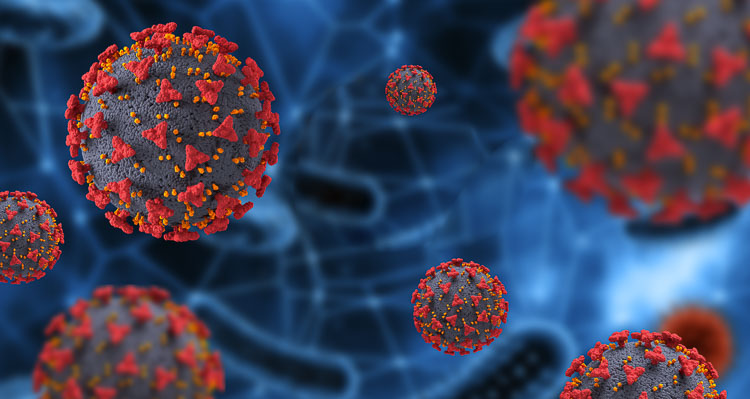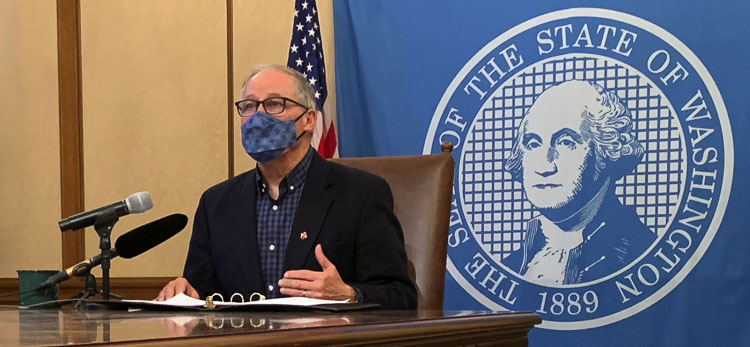Todd Myers of the Washington Policy Center gives an in-depth analysis of the state’s performance during the pandemic

This opinion piece was produced and first published by the Washington Policy Center. It is published here with the permission of and full attribution to the Washington Policy Center.
Todd Myers
Washington Policy Center

As state agencies missed self-imposed targets for testing, contact tracing, and vaccinations, the Inslee Administration consistently denied the failures, even calling the poor performance, “encouraging.”
• Since the beginning of the pandemic, the Inslee Administration consistently failed to meet its own goals to contain the spread of the coronavirus.
• Despite noting that “more testing” was key to limiting the impact of COVID, state testing rates were actually declining three months into the pandemic.
• As COVID cases spiked in November, the Department of Health’s contact tracing program collapsed, achieving less than 10 percent of its own goal.
• Washington had one of the worst vaccine rollouts, lagging behind more than 40 states in distribution and failing to reach the most vulnerable for the first two months the vaccines were available.
• During each of these failures, state officials were consistently in denial, claiming they were doing “better than expected,” saying the poor numbers were “actually quite encouraging,” or claiming their own numbers were wrong.
• The consistent pattern of failure and denial from state officials is a clear lesson that in future crises, more responsibility and faith should be put in the hands of the people of Washington since they pay the price for the repeated failures of state politicians.

As I noted in the previous blog, any positive effect of the lockdowns and mask requirements, while not zero, was primarily due to personal efforts, not government mandates. Throughout the pandemic, people made personal choices to self-quarantine, or to go out in public to work, visit friends, or join protest marches, based on their own assessment of health risk.
However, there are three areas in which state government and the Washington State Department of Health played the key role: testing, contact tracing, and vaccine distribution. All three of these activities were important in finding and containing the spread of the coronavirus. In all three areas, the performance of the state was abysmal, even by its own standards.
The repeated failure of state government and the Inslee Administration to do the jobs it claimed were important is another lesson showing that when our state faces serious problems, it is the people of Washington, not government officials, who can be most relied on.
In the following sections, using public sources, I report on the three key public health areas in which Washington’s leaders badly under-performed.
COVID Testing
Early in the pandemic, state officials struggled to discover the extent of the spread of the virus. The delay between infection and the first noticeable symptoms of COVID meant people could unintentionally spread the illness. Testing was a critical part of finding those who were infected, treating them, and reducing further spread.
The University of Washington’s Institute for Disease Modeling, on which the governor says he relied for science advice about containing the virus, said “faster and more testing” was extremely effective at reducing the spread of COVID and in allowing a greater level of economic reopening. Unfortunately, that sound advice did not translate into improved testing rates.
By the end of May 2020, three months after the first COVID cases were discovered in Washington, testing rates were at the same level they had been at the end of April. Despite the failure, the Inslee Administration was in denial. When a reporter from the Daily Olympian asked in early May about the low test numbers , an Inslee spokesman claimed the testing rate was “roughly similar,” even as their own data showed the rate of testing was actually declining.
Later in May, Governor Inslee claimed the state was completing 8,000 daily tests when the true number was about 5,000. Then-Health Secretary John Weisman claimed testing was increasing even as it was declining. Rather than acknowledging the problem and working to fix it, the administration denied it even existed.
The testing rates were poor even by the state’s own metrics. Department of Health (DOH) officials set a goal to test 50 people for every new COVID case, posting the information on their online dashboard. At the beginning of June 2020, they were testing only 19.5 people per new case, less than half of their goal.
Testing finally began to increase in mid-June, but by that point the virus had spread widely and the state’s testing program was playing catch up. The number of cases began to increase in late May and the testing ended up simply documenting the summer case spike, rather than playing a role in preventing it.
Contact tracing
Like testing, contact tracing is a tool the state can use to identify those who may have been infected, helping them limit contact and stop the spread of the illness. Describing the value of contact tracing, Amy Maxmen, senior reporter at the science journal Nature, told the BBC that with accurate tracing when government officials say, “Let’s everybody shut down all businesses, shut down the schools, instead they’re able to really target their approach.” That targeted approach didn’t happen in Washington.
Acknowledging the potential value of tracing, DOH officials set a target of reaching 90 percent of people with a positive COVID test within one day. That would allow DOH to identify others with whom the infected patient came in contact and alert them. Even when case rates were low, the state consistently fell well short of that goal, briefly reaching a maximum of 65 percent. As the number of cases increased rapidly in November 2020, that number plummeted.
In late November when the state struggled to contain another wave of the illness, DOH reached only six percent of people who tested positive. The problem wasn’t that people didn’t respond. Indeed, more than half of the people who were called were reached within 24 hours. The problem was DOH was only attempting to reach 12 percent of COVID-positive patients. At a time when contact tracing was needed most – when case rates were exploding around the state – the DOH program collapsed. With the failure of contact tracing to control the spread, Governor Inslee again put the state into lockdown in November.
What was the agency’s public response to their own failure? In early December, when DOH was reaching fewer than 10 percent of people with positive COVID tests, officials told The News Tribune they were doing “better than expected.”
Contract tracing rates began to rebound in mid-December, but by that time the number of cases had been falling for weeks. When the state effort was needed most, it failed.
The state did attempt one unique strategy that I thought was very worthwhile. A voluntary COVID-tracing app allowed people to be notified if they had been in the vicinity of someone who had tested positive. I was one of the few people who praised the idea and I used the app myself. Many worried about their privacy and didn’t use it. That is not the state’s fault, and I still think it was worth trying, even if it didn’t work as hoped. In a pandemic, it makes sense to try a variety of strategies because the cost of involuntary lockdowns is so extreme.
In the end, there is no substitute for officials simply doing the basic work of contacting people, and DOH failed badly, both objectively and according to its own announced goals.
Vaccine rollout
I was vaccinated on the first day I became eligible, April 15, 2021. At that point, most states had opened vaccination up to everyone. Washington’s vaccine rollout was plagued by politics, bad planning, and self-delusion that put us well behind most of the country for months.
The problems began immediately. On December 2, 2020 when asked about distribution of the vaccine, Governor Inslee told MSNBC, “We are in good shape on that distribution plan.” When the vaccines arrived, however, it was clear the state was not ready.
In December 2020, hundreds of thousands of doses were delivered to Washington state. By the end of the year only about 20 percent of those doses had been distributed. On January 5, according to the Bloomberg Vaccine Tracker, Washington ranked 43rd in the nation in the percentage of doses administered. When asked about the failure to distribute the shots, the governor said he thought it was “actually quite encouraging.”
By mid-February, Washington was still lagging, and The Seattle Times noted, “After two months and more than a million doses administered, the state has struggled to vaccinate some of the people at highest risk for disease.”
Rather than focus on logistics, The Times reported that officials at DOH, “…agonized over which residents should be vaccinated before others. They surveyed 18,000 people and convened focus groups, debating race, age and essential occupations.”
Late in January, Washington state announced a partnership with Starbucks, Microsoft, and Costco to help distribute vaccines. With the logistical support of these private companies, the rate of distribution finally increased.
Conclusion
Each of these three essential policy areas were the sole responsibility of state government. In each case, state officials, including the governor, highlighted the importance of these efforts and set targets for success. And every time, they failed badly.
The people of Washington performed well in the pandemic, taking voluntary precautions that limited the spread of the coronavirus and keeping the economy going as best they could under difficult circumstances. It is not surprising that politicians would grasp at claiming success for the sacrifices made by others. The record of government performance during the last year and a half, however, demonstrates that when there was a job to do and help was desperately needed to control the spread of the virus, state leadership and state agencies weren’t up to the task.
Todd Myers is the director of the Center for the Environment at the Washington Policy Center.





It is certainly glorious to be able to look ‘back’ at a situation and be critical to it. The covid situation has been fluid and ever changing since it began. If you remember at the beginning getting tested was limited by bad test kits, not enough, etc. By the time sufficient test kits became available the virus was so widespread that contact tracing was impossible, I am not sure what state did contact tracing well. As for the vaccine rollout— it would have been nice for the Federal government to take that over.. but the Trump team failed miserably at this. They had the vaccine made, bought it, and “poof” what do we do with it. No plan to roll it out to individual states or any direction for those states to distribute within those states. This was a National health crisis with NO NATIONAL plan. Individual governors had to make hard choices on their own with no guidance. While not perfect- nobody is, Inslee did the best he could with the info he had at the time. Walk a mile in his shoes before being to critical, Todd.
Too big of a job for the federal goverment. It needed to be delegated to the states. Inslee failed.
For those of us that believe data and facts are more important than partisanship, here is how Washington actually performed:
https://www.sykes.com/resources/reports/2021-best-worst-covid19-fighting-states-america/
https://www.wbaltv.com/article/uc-berkeley-study-ranks-states-responses-covid-19-pandemic/36050044
https://www.politico.com/news/2020/10/14/best-state-responses-to-pandemic-429376
https://www.usnews.com/news/best-states/articles/2020-03-17/10-states-with-the-most-aggressive-response-to-coronavirus
I could literally list dozens of additional studies, from nonpartisan sources, that have Washington performing extremely well when compared to other states. I understand the Washington Policy Center has an agenda, but there are plenty of things you can take Inslee to task for without being this disingenuous.
Thanks for sharing factual Truth. Gov. Inslee did the best he could under the circumstances l